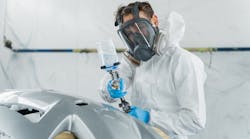Last month in this space we discussed the importance of a perfect work order when launching into a vehicle repair job, and I introduced my colleague Bob Gilbert, a noted process consultant for AkzoNobel Automotive and Aerospace Coatings, who is pretty adamant that a very small percentage of shops around the country get that part of the repair process correct.
Bob is an instructor with AkzoNobel's "PCE Boot Camp," a class specifically developed to teach shops the benefits of a process-centered environment (PCE). Through a series of building blocks, Bob and his crew teach the thought process involved in creating a team-based approach to efficient production while training staff to better understand the vital components of a process-centered shop.
Bob teaches the benefits of upstream planning, which positively affect downstream progress in the repair process. And in his journeys through shops across North America, Bob has realized that only a rare few shops approach a very high level of accuracy in their initial repair assessment.
"There are probably 40,000 shops in the U.S. and Canada, and of all those shops, I'd venture to say that only 25 or so really get it right even 90% of the time on a consistent, measured basis," he says. "The intent is definitely there for most shops, but there are two main driving factors that are getting in the way of perfection in this business."
The first factor, according to Bob, is measurement. It's the ability to record and document the flow of vehicles through the shop, and how often those vehicles halt the process, or require supplements.
"The lack of measurement is the biggest problem," he says. "And in the absence of knowing how well a shop is doing, management and staff can only assume that they're doing well. An efficient shop needs constant feedback that it's only getting things right 50% of the time. You need audit sheets and accurate databases. You need to call another tech to double check and verify. If you just assume that you're good at it, you'll never know how inefficient the process really is."
Bob notes that a common mentality in this business is to "just get the job started and we'll get it down the line." But then things ultimately get worse. "In our business, it's basically acceptable to be wrong," he says. "That's because we have a get-out-of-jail-free card called the Supplement, which will let me recoup the cost of inefficiency. The problem is that it costs an average of $250 every time you miss-analyze a car because of the starting and stopping at every activity on the floor. And that usually happens multiple times with each job."
The second factor is human behavior. Simply put, if your staff is working in an environment that puts constant pressure on them to produce, you'll see accuracy take a plunge.
"You need to take into account the psychological aspect of human behavior," comments Bob. "You need to understand why and how people behave. And that stress and pressure are the tipping points to mistakes on the floor and inefficient production."
When your shop has a parking lot full of vehicles waiting to enter the system, when jobs are piled up in front of the paint booth (or any other area on the floor), that's a non-verbal clue that a technician needs to shake a leg. And that leads to cutting corners and mistakes.
"Pressure affects people in different ways, but mostly the wrong way," says Bob. "Somehow you have to isolate your staff from feeling that pressure on the floor. Perhaps you need to optimize the volume of work to expand capacity by hiring more people to reduce the pressure. A team-based, process-centered environment is a great solution to alleviate these problems, but the process is still attached to two hands that are driven by one brain. So you have to consider the human behavior component of the operation to succeed."
How good is your shop at accuracy? If you know you're missing a component in the pre-planning process, do you send it downstream anyhow? Are you measuring your production accurately? And how are you monitoring (and managing) the pressure points on the shop floor? As an industry, we all know that accuracy up front is the ultimate key to success, yet it remains the greatest challenge. A 95% accuracy rate just doesn't cut it and still halts the flow downstream.

